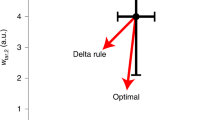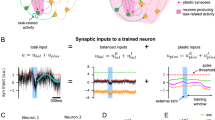Abstract
The brain is believed to operate in part by making predictions about sensory stimuli and encoding deviations from these predictions in the activity of “prediction error neurons.” This principle defines the widely influential theory of predictive coding. The precise circuitry and plasticity mechanisms through which animals learn to compute and update their predictions are unknown. Homeostatic inhibitory synaptic plasticity is a promising mechanism for training neuronal networks to perform predictive coding. Homeostatic plasticity causes neurons to maintain a steady, baseline firing rate in response to inputs that closely match the inputs on which a network was trained, but firing rates can deviate away from this baseline in response to stimuli that are mismatched from training. We combine computer simulations and mathematical analysis systematically to test the extent to which randomly connected, unstructured networks compute prediction errors after training with homeostatic inhibitory synaptic plasticity. We find that homeostatic plasticity alone is sufficient for computing prediction errors for trivial time-constant stimuli, but not for more realistic time-varying stimuli. We use a mean-field theory of plastic networks to explain our findings and characterize the assumptions under which they apply.









Similar content being viewed by others
References
Ahmadian, Y., & Miller, K. D. (2021). What is the dynamical regime of cerebral cortex? Neuron, 109(21), 3373–3391.
Akil, A. E., Rosenbaum, R., Josić, K. (2021). Balanced networks under spike-time dependent plasticity. PLoS Computational Biology, 17(5):e1008,958.
Amit, D., & Brunel, N. (1997). Model of global spontaneous activity and local structured activity during delay periods in the cerebral cortex. Cereb Cortex, 7(3), 237–252.
Attinger, A., Wang, B., & Keller, G. B. (2017). Visuomotor coupling shapes the functional development of mouse visual cortex. Cell, 169(7), 1291–1302.
Baker, C., Ebsch, C., Lampl, I., Rosenbaum, R. (2019). Correlated states in balanced neuronal networks. Physical Review E, 99(5):052,414.
Baker, C., Zhu, V., Rosenbaum, R. (2020). Nonlinear stimulus representations in neural circuits with approximate excitatory-inhibitory balance. PLoS Computational Biology, 16(9):e1008,192.
Bastos, A. M., Usrey, W. M., Adams, R. A., Mangun, G. R., Fries, P., & Friston, K. J. (2012). Canonical microcircuits for predictive coding. Neuron, 76(4), 695–711.
Bogacz, R. (2017). A tutorial on the free-energy framework for modelling perception and learning. Journal of Mathematical Psychology, 76, 198–211.
Brette, R., & Gerstner, W. (2005). Adaptive exponential integrate-and-fire model as an effective description of neuronal activity. Journal of Neurophysiology, 94(5), 3637–3642.
Brunel, N. (2000). Dynamics of sparsely connected networks of excitatory and inhibitory spiking neurons. Journal of Computational Neuroscience, 8(3), 183–208.
Brunel, N., & Hakim, V. (1999). Fast global oscillations in networks of integrate-and-fire neurons with low firing rates. Neural Computation, 11(7), 1621–1671.
Capogna, M., Castillo, P. E., & Maffei, A. (2021). The ins and outs of inhibitory synaptic plasticity: Neuron types, molecular mechanisms and functional roles. European Journal of Neuroscience, 54(8), 6882–6901.
Castillo, P. E., Chiu, C. Q., & Carroll, R. C. (2011). Long-term plasticity at inhibitory synapses. Current Opinion in Neurobiology, 21(2), 328–338.
Clark, A. (2015). Surfing uncertainty: Prediction, action, and the embodied mind. Oxford University Press.
Ebsch, C., Rosenbaum, R. (2018). Imbalanced amplification: A mechanism of amplification and suppression from local imbalance of excitation and inhibition in cortical circuits. PLoS Computational Biology, 14(3):e1006,048.
Friston, K. (2010). The free-energy principle: a unified brain theory? Nature Reviews Neuroscience, 11(2), 127–138.
Gerstner, W., Kistler, W. M., Naud, R., Paninski, L. (2014). Neuronal dynamics: From single neurons to networks and models of cognition. Cambridge University Press.
Hennequin, G., Agnes, E. J., Vogels, T. P. (2017). Inhibitory Plasticity: Balance, Control, and Codependence. Annual Review of Neuroscience, 40(1):557–579. 10.1146/annurev-neuro-072116-031005, URL http://www.annualreviews.org/doi/10.1146/annurev-neuro-072116-031005
Hertäg, L., Clopath, C. (2021). Prediction-error neurons in circuits with multiple neuron types: Formation, refinement and functional implications. bioRxiv.
Hertäg, L., & Sprekeler, H. (2020). Learning prediction error neurons in a canonical interneuron circuit. Elife, 9(e57), 541.
Homann, J., Koay, S. A., Chen, K. S., Tank, D. W., & Berry, M. J. (2022). Novel stimuli evoke excess activity in the mouse primary visual cortex. Proceedings of the National Academy of Sciences, 119(5).
Jordan, R., & Keller, G. B. (2020). Opposing influence of top-down and bottom-up input on excitatory layer 2/3 neurons in mouse primary visual cortex. Neuron, 108(6), 1194–1206.
Keller, G. B., & Mrsic-Flogel, T. D. (2018). Predictive processing: a canonical cortical computation. Neuron, 100(2), 424–435.
Keller, G. B., Bonhoeffer, T., & Hübener, M. (2012). Sensorimotor mismatch signals in primary visual cortex of the behaving mouse. Neuron, 74(5), 809–815.
Landau, I. D., Egger, R., Dercksen, V. J., Oberlaender, M., & Sompolinsky, H. (2016). The impact of structural heterogeneity on excitation-inhibition balance in cortical networks. Neuron, 92(5), 1106–1121.
Leinweber, M., Ward, D. R., Sobczak, J. M., Attinger, A., & Keller, G. B. (2017). A sensorimotor circuit in mouse cortex for visual flow predictions. Neuron, 95(6), 1420–1432.
Lim, S., & Goldman, M. S. (2014). Balanced cortical microcircuitry for spatial working memory based on corrective feedback control. The Journal of Neuroscience, 34(20), 6790–6806.
Luz, Y., Shamir, M. (2012). Balancing feed-forward excitation and inhibition via hebbian inhibitory synaptic plasticity. PLoS Computational Biology, 8(1):e1002,334.
Pyle, R., Rosenbaum, R. (2016). Highly connected neurons spike less frequently in balanced networks. Physical Review E, 93(4):040,302(R).
Pyle, R., Rosenbaum, R. (2017). Spatiotemporal dynamics and reliable computations in recurrent spiking neural networks. Physical Review Letter, 118(1):018,103.
Rao, R. P., & Ballard, D. H. (1999). Predictive coding in the visual cortex: a functional interpretation of some extra-classical receptive-field effects. Nature neuroscience, 2(1), 79–87.
Rao, R. P., Sejnowski, T. J. (2002). Predictive coding, cortical feedback, and spike-timing dependent plasticity. Probabilistic models of the brain p 297.
Renart, A., de La Rocha, J., Bartho, P., Hollender, L., Parga, N., Reyes, A., & Harris, K. (2010). The Asynchronous State in Cortical Circuits. Science, 327(5965), 587–590.
Rosenbaum, R., Doiron, B. (2014). Balanced networks of spiking neurons with spatially dependent recurrent connections. Physical Review X, 4(2):021,039. 101103/PhysRevX4021039. URL http://linkaps.org/doi/101103/PhysRevX4021039
Saxena, S., & Cunningham, J. P. (2019). Towards the neural population doctrine. Current opinion in neurobiology, 55, 103–111.
Schulz, A., Miehl, C., Berry, M. J., II., & Gjorgjieva, J. (2021). The generation of cortical novelty responses through inhibitory plasticity. Elife, 10(e65), 309.
Turrigiano, G. (2011). Too many cooks? intrinsic and synaptic homeostatic mechanisms in cortical circuit refinement. Annual review of neuroscience, 34, 89–103.
Vogels, T. P., Sprekeler, H., Zenke, F., Clopath, C., Gerstner, W. (2011). Inhibitory plasticity balances excitation and inhibition in sensory pathways and memory networks. Science, 334(6062):1569–73. 10.1126/science.1211095, URL http://www.ncbi.nlm.nih.gov/pubmed/22075724
Vogels, T. P., Froemke, R. C., Doyon, N., Gilson, M., Haas, J. S., Liu, R., Maffei, A., Miller, P., Wierenga, C. J., Woodin, M. A., Zenke, F., Sprekeler, H. (2013). Inhibitory synaptic plasticity: spike timing-dependence and putative network function. Frontiers in Neural Circuits, 7(119). https://doi.org/10.3389/fncir.2013.00119
Von Helmholtz, H. (1867). Handbuch der physiologischen Optik: mit 213 in den Text eingedruckten Holzschnitten und 11 Tafeln, vol 9. Voss.
van Vreeswijk, C., & Sompolinsky, H. (1996). Chaos in neuronal networks with balanced excitatory and inhibitory activity. Science, 274(5293), 1724–1726.
van Vreeswijk, C., & Sompolinsky, H. (1998). Chaotic balanced state in a model of cortical circuits. Neural Computation, 10(6), 1321–1371.
van Vreeswijk, C., & Sompolinsky, H. (2005). Methods and models in neurophysics course 9: Irregular activity in large networks of neurons. Les Houches, 80, 341–406.
Wacongne, C., Changeux, J. P., & Dehaene, S. (2012). A neuronal model of predictive coding accounting for the mismatch negativity. Journal of Neuroscience, 32(11), 3665–3678.
Whittington, J. C., & Bogacz, R. (2019). Theories of error back-propagation in the brain. Trends in Cognitive Sciences, 23(3), 235–250.
Funding
This work was supported by US National Foundation of Science grants NSF-DMS-1654268 and NSF NeuroNex DBI-1707400 and Air Force Office of Scientific Research (AFOSR) award number FA9550-21-1-0223.
Author information
Authors and Affiliations
Corresponding author
Ethics declarations
Conflicts of interest
The authors have no conflicts of interest to disclose.
Additional information
Action Editor: Nicolas Brunel
Publisher’s Note
Springer Nature remains neutral with regard to jurisdictional claims in published maps and institutional affiliations.
Supplementary Information
Below is the link to the electronic supplementary material.
Rights and permissions
About this article
Cite this article
Zhu, V., Rosenbaum, R. Evaluating the extent to which homeostatic plasticity learns to compute prediction errors in unstructured neuronal networks. J Comput Neurosci 50, 357–373 (2022). https://doi.org/10.1007/s10827-022-00820-0
Received:
Revised:
Accepted:
Published:
Issue Date:
DOI: https://doi.org/10.1007/s10827-022-00820-0




